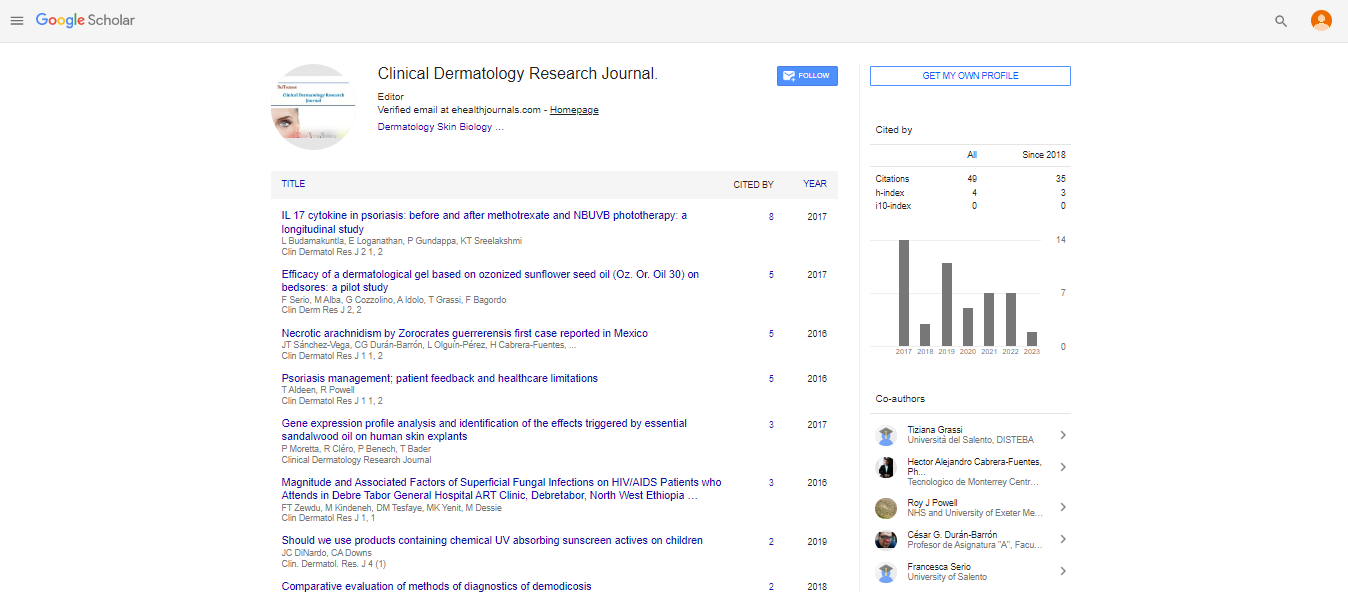New formulations of melatonin to prevent aging skin
Germaine Escames
University of Granada, Spain
: J Clin Exp Dermatol Res
Abstract
Melatonin, a hormone produced by the pineal gland, has been also detected in multiple extra pineal organs and tissues at much more higher concentrations than in the pineal gland. Melatonin synthesis has been demonstrated in skin cells, and its expression was located in the upper layers of the epidermis, dermal structures, blood vessels and mast cells by immunocytochemistry. Melatonin is a potent free radical scavenger with antioxidant properties, which increases the expression and activity of the endogenous antioxidant enzymes. During its scavenging activity, melatonin generates a series of metabolites that are also free radical scavengers. Capable of crossing cell membranes, melatonin can reach all cell compartments; it is taken up by mitochondria where it maintains mitochondrial homeostasis. Melatonin has also important anti-inflammatory effects, reducing the innate immune activation. Recently, we have developed a pharmaceutical preparation of melatonin plus CoQ10 for the treatment and prevention of skin aging. The success of this preparation depends on its composition, which facilitates its transdermal adsorption, reaching both molecules all skin´s layers. Moreover, the combination of both molecules favors their uptake by the mitochondria in all skin cells. The advantage of our product is that it not only reverses the mitochondrial damage produced during cellular aging, but also improves skin’s health in many pathologies coursing with oxidative stress, inflammation and mitochondrial impairment. Additionally, after reported a melatonin’s gel that protects normal cells from oral mucositis induced by radio or chemotherapy, we have demonstrated that high melatonin concentrations enhance the cytotoxicity of radio and chemotherapy in head and neck human cancer. Therefore, melatonin might be useful in the treatment of pigmentary diseases (e.g. vitiligo or hyperpigmentation), benign or malignant proliferative processes (melanoma, epidermal cancer or precancerous states), UVB-induced pathology, inflammatory dermatoses and other skin pathologies, besides skin aging. Recent Publications 1. Slominski A, Fischer T W, Zmijewski M A, et al. (2005) On the role of melatonin in skin physiology and pathology. Endocrine 27(2):137-148. 2. Slominsk A, Tobin D J, Zmijewski M A, et al. (2007) Melatonin in the skin: synthesis, metabolism and functions. TRENDS in Endocrinology and Metabolism 19(1):17-24. 3. Shen Y Q, Guerra-Librero A, Fernandez-Gil BI, et al. (2017) Combination of melatonin and rapamycin for head and neck cancer therapy: suppression of AKT/mTOR pathway activation, and activation of mitophagy and apoptosis via mitochondrial function regulation. J Pineal Res 64:3. 4. Abdel Moneim A E, Guerra-Librero A, Florido J, et al. (2017) Oral mucositis: melatonin gel an effective new treatment. Int J Mol Sci. 18(5). 5. Ortiz F, Acuña-Castroviejo D, Doerrier C, et al. (2015) Melatonin blunts the mitochondrial/NLRP3 connection and protects against radiation-induced oral mucositis. J Pineal Res 58(1):34-49.
Biography
Germaine Escames is a Professor at Granada University School of Medicine from Spain and has broad experience in the studies of the antioxidative role of melatonin and the identification of the mitochondria as the main target of melatonin, and its anti-inflammatory activity against the innate immune response, among others. From several years to date, her activity has been focused on the oncostatic activity of melatonin and the adverse effects of radio and chemotherapy. In addition, she studied the effects of melatonin on the skin. She has four international patents on melatonin: one is currently under a multicentric clinical trial (in 10 hospitals of Spain) for the prevention and healing of oral mucositis induced by radio and/or chemotherapy, and other two patents consist of an endovenous melatonin formulation for the treatment of sepsis. The fourth patent consists in a regenerative and anti-aging cream of melatonin for its topic application in the skin. A clinical trial with this cream to treat position ulcers is now being carried out in collaboration with other groups.
E-mail: gescames@ugr.es
 Spanish
Spanish  Chinese
Chinese  Russian
Russian  German
German  French
French  Japanese
Japanese  Portuguese
Portuguese  Hindi
Hindi 

